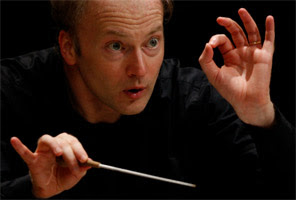Britten's War Requiem at the White Light Festival.
 |
| Okey-Dokey. Conductor Gianandrea Noseda led huge forces in Sunday's War Requiem. Photo by John Super © 2011 London Symphony Orchestra. |
The enormous resources called for in Benjamin Britten's War Requiem were almost beyond the means of Avery Fisher Hall on Sunday afternoon. They included the full strength of the London Symphony Orchestra and Chorus, a small chamber orchestra (drawn from LSO players and squeezed in around the conductor's podium), three vocal soloists and the American Boychoir. The kids had to sing through a door leading offstage.
In these tight quarters, the spacious antiphonies of this complicated work (premiered in 1962 at the dedication of the new Coventry Cathedral following the destruction of the original by Luftwaffe bombs in 1940) didn't quite work. Giandrea Noseda did an admirable job of marshaling his forces, achieving a remarkable aural balance of the four groups. He conducted with vigor.
The London Symphony Chorus was a force unto itself, declaiming the Latin text of the mass with the authority of the Metatron. The fiery incantations of the Dies Irae (featuring ear-splitting playing from the brass in the "Tuba Mirum") blazed forth with power. They were also key contributors to the success of the later movements, especially the slow-moving setting of the Agnus Dei.
The Offertorium is the dark heart of this strange piece. Here, the composer re-tells the story of Abraham and Isaac. However, Isaac is sacrificed by his father in the accompanying Wilfred Owen poem: an echo of the horrors of war. This is Britten at his most cutting. The hollow fugue at the end was a grim, Shostakovich-like joke.
Tenor soloist Ian Bostridge sang repertory that was suited to his unique instrument. Mr. Bostridge took advantage of Britten's high vocal lines, airing them easily over the chamber ensemble. He added emotional weight to these words, making the bleak landscapes of war-torn Europe flicker with ghostly light.
He was paired with baritone Simon Keenlyside, an opera star in his own right. Mr. Keenlyside's smallish, dark-hued instrument was perfect for "At the thrust of Lightning in the East" in the Sanctus. Soprano Sibina Civilak also sang beautifully from the space between the orchestra and chorus, tossing off some glorious notes in the Lacrimosa.
The small cadre of boy trebles also made an important contribution from their offstage post. The two singers joined voices on on the last poem, "Strange Meeting." The scene: an encounter between two wounded enemy soldiers in a tunnel full of corpses. As Mr. Bostridge and Mr. Keenlyside sang out the lines of the poem, the women of the LSO Chorus echoed with "In paradisum" from the Libera me section of the Mass. This made for a stratospheric, if icy climax.
Benjamin Britten was a committed pacifist, and did not pull punches in his work that combines the Latin Mass for the Dead with battlefield poetry. This is one of the composer's most dramatic and most popular pieces, a work that is all too apt for today's audiences. The White Light Festival may be about bringing its audience out of their daily lives, but under Mr. Noseda the Requiem was a sharp reminder of reality.


